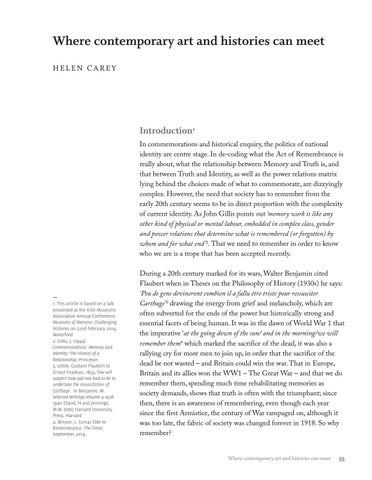Where contemporary art and histories can meet HELEN CAREY
Introduction1 In commemorations and historical enquiry, the politics of national identity are centre stage. In de-coding what the Act of Remembrance is really about, what the relationship between Memory and Truth is, and that between Truth and Identity, as well as the power relations matrix lying behind the choices made of what to commemorate, are dizzyingly complex. However, the need that society has to remember from the early 20th century seems to be in direct proportion with the complexity of current identity. As john Gillis points out ‘memory work is like any other kind of physical or mental labour, embedded in complex class, gender and power relations that determine what is remembered (or forgotten) by whom and for what end’2. That we need to remember in order to know who we are is a trope that has been accepted recently.
— 1. This article is based on a talk presented at the Irish Museums Association Annual Conference, Museums & Memory: Challenging Histories on 22nd February 2014, Waterford 2. Gillis, J. (1994) Commemorations: Memory and Identity: The History of a Relationship, Princeton 3. Letter, Gustave Flaubert to Ernest Feydeau, 1859, Few will suspect how sad one had to be to undertake the resuscitation of Carthage. In Benjamin, W. Selected Writings Volume 4 19381940 Eiland, H and Jennings, M.W. (eds) Harvard University Press, Harvard 4. Binyon, L. (2014) Ode to Remembrance. The Times September 2014.
During a 20th century marked for its wars, Walter Benjamin cited Flaubert when in Theses on the Philosophy of History (1930s) he says: ‘Peu de gens devineront combien il a fallu être triste pour ressusciter Carthage’3 drawing the energy from grief and melancholy, which are often subverted for the ends of the power but historically strong and essential facets of being human. It was in the dawn of World War 1 that the imperative ‘at the going down of the sun/ and in the morning/we will remember them4 which marked the sacrifice of the dead, it was also a rallying cry for more men to join up, in order that the sacrifice of the dead be not wasted – and Britain could win the war. That in Europe, Britain and its allies won the WW1 – The Great War – and that we do remember them, spending much time rehabilitating memories as society demands, shows that truth is often with the triumphant; since then, there is an awareness of remembering, even though each year since the first Armistice, the century of War rampaged on, although it was too late, the fabric of society was changed forever in 1918. So why remember?
Where contemporary art and histories can meet
55













